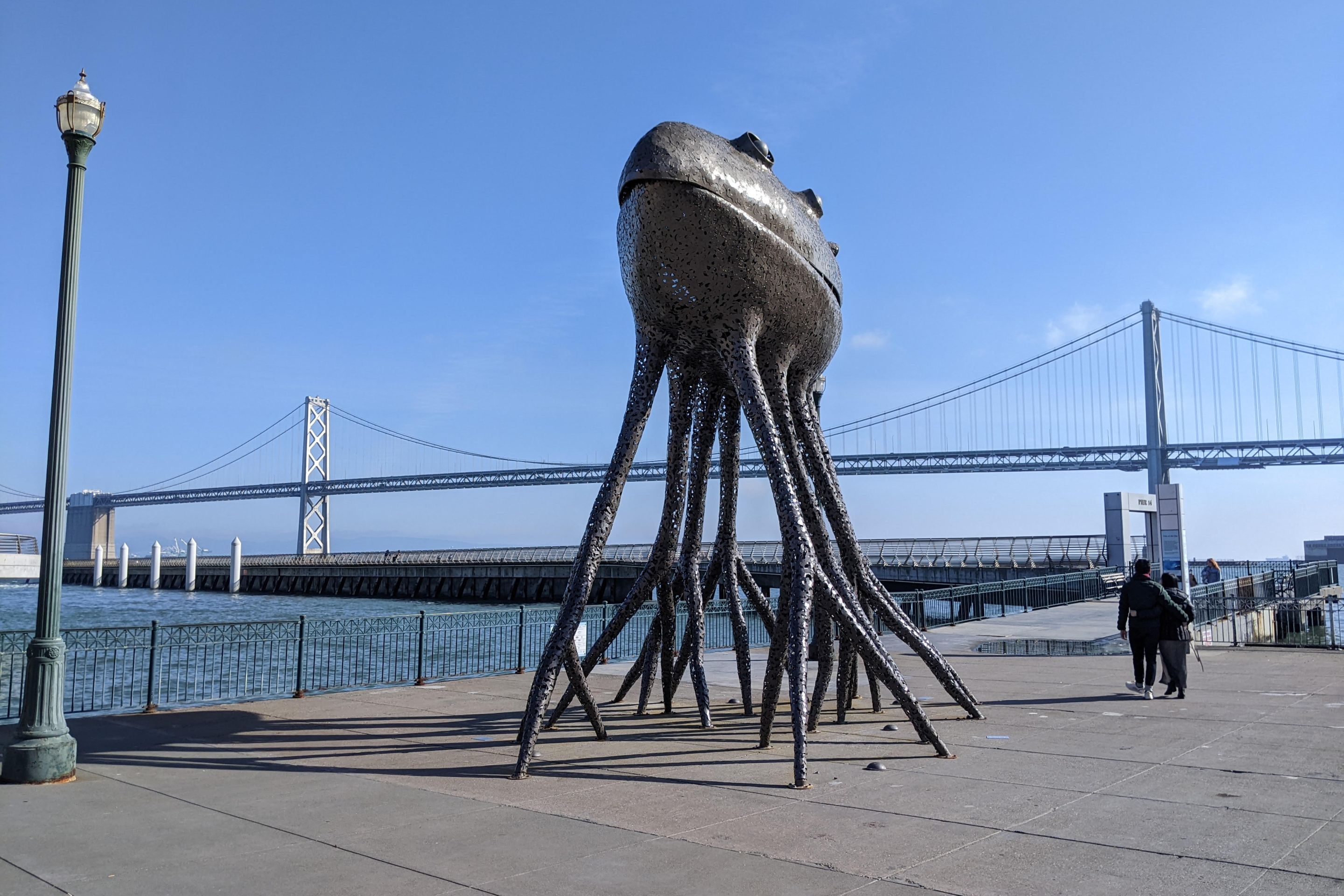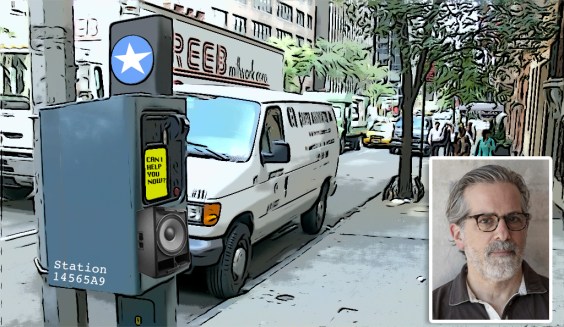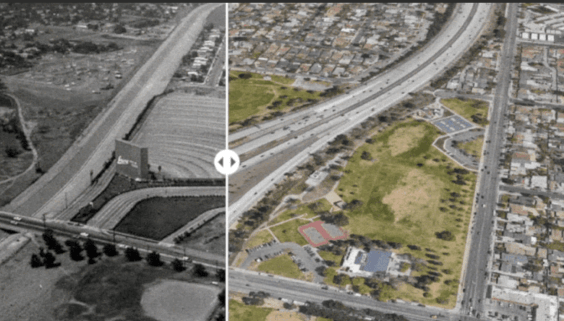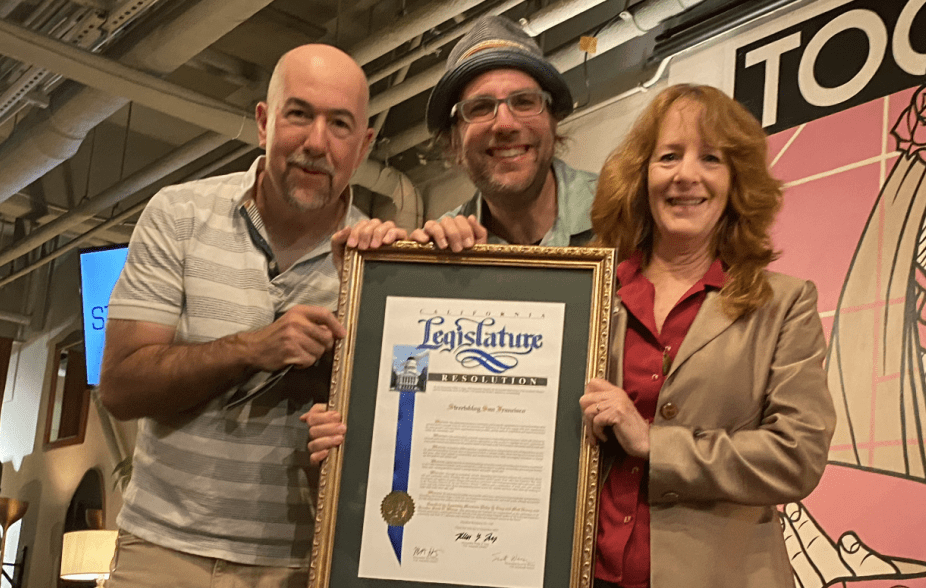 Massive yellow structures called "sea fasteners" help insulate the delicate cargo during its trans-Pacific voyage. Photos: Jackson Solway
Massive yellow structures called "sea fasteners" help insulate the delicate cargo during its trans-Pacific voyage. Photos: Jackson Solway For the engineers toiling to complete the replacement of the Bay Bridge, their ship has finally come in.
After more than than 15 months of delays spurred by weld fabrication and inspection issues, the first steel sections for the highly publicized signature span glided across the Bay Thursday afternoon.
"This is the moment we will actually see this bridge come to life," Caltrans spokesperson Bart Ney said to a small group of journalists at a press event.
When the barge carrying eight 1100-ton sections arrived at Oakland's Pier 7, it was ahead of schedule for a change.
Upon seeing the cargo for the first time, Metropolitan Transportation Commission executive director Steve Heminger said, "it's about time."
The freighter, called the Zhen Hua 17, arrived six days early, and could have coasted through the Golden Gate one day sooner if not for this week's El-Nino-like storm surge, which pummeled the Bay Area with high winds and heavy rains.
Rough seas Wednesday forced the freighter into a holding pattern about 40 miles off shore from the Golden Gate, and was one of three ships delayed that day.
Even in better weather, San Francisco bar pilots navigate large vessels through the Bay's gauntlet of narrow shipping channels, sand bars and whipping winds.
 The vessel's Chinese crew, shown here on deck during a break in Thursday's heavy rains.
The vessel's Chinese crew, shown here on deck during a break in Thursday's heavy rains. For the Bay Bridge replacement project - one rife with years of setbacks stemming from political imbroglios, management gaffes and miscalculated costs - the arrival of the wing-shaped steel pieces is physical proof that the bridge is one step closer to completion.
Pete McIsaac, president of the San Francisco Bar Pilot's Association, said, tempest aside, part of the reason bar pilots couldn't board the ship has to do with the shape of its hull.
Most container ships have flat-sided hulls, allowing the bar pilot's ship to safely bob alongside the massive sealiners until weather permits boarding. The Zhen Hua 17 is much different: narrow at the waterline, its hull drastically flares to 32-meters wide at some points, much like the hull of an aircraft carrier.
That type of hull can "completely destroy the boat if there's a sea running," McIsaac said, like Wednesday's 12-foot sea swells that have been tossing around the smaller bar pilot boats.
Thursday's choppy seas threatened to keep the freighter stranded. But when the storms broke around noon, the 225-meter long Zhen Hua 17 had a date with the bar pilot who assisted it into the moor at Pier 7, the project staging area just south of the existing Bay Bridge.
"We've been at the whims of the weather with this ship coming in," said American Bridge project engineer Mike Flowers, whose firm is the prime contractor on the project.
 The first of four shipments for the suspension span deck floats on the Zhen Hua 17 at Pier 7 in Oakland.
The first of four shipments for the suspension span deck floats on the Zhen Hua 17 at Pier 7 in Oakland. So, a bit bedraggled from the rain, the precious cargo made it in.
It was a much different story at the start of the voyage. The skies were clear over Shanghai's Changxing Island at the end of December, and the only thing raining from the sky was confetti.
There, at the expansive facility of Zhenhua Heavy Industry Company - known better by its former name of Zhenhua Port Machinery Company, or ZPMC for short - more than 2,000 workers have labored for years virtually around the clock to churn out the steel for this project. According to a Caltrans press release, executives from ZPMC and Caltrans brandished scissors for some ceremonious ribbon-cutting and workers lit firecrackers for good luck as the 25-year old vessel waded through the Yangtze River and into the mouth of the vast Pacific Ocean.
Caltrans and American Bridge engineers in Oakland, while perhaps not as superstitious, were not as celebratory either on the rainy grey afternoon. A cluster of journalists slogged out to the Port to catch a glimpse of the hulking Zhen Hua 17, which was skirted at the pier by a smaller tugboat called the Millennium Falcon.
"It's not something that played out well for some big public event," Ney said, "And that's fine because we're focused on getting the bridge built."
Flowers said internal discussions among project mangers led to the decision to wait to break out the champagne until the next shipping milestone, when the tower sections arrive in late spring or early summer. (Note how project managers talk in seasons with this project, not months.)
"The tone for the Bay Bridge team is extreme exuberance, we've been working really hard on getting these segments here," Ney said.
 Birds take flight on the grey Thursday afternoon against the background of the freighter.
Birds take flight on the grey Thursday afternoon against the background of the freighter. In the meantime, the site of the new suspension span has been bustling with activity. Construction crews have been preparing for the deck sections' arrival since last March.
Using the aptly named Left Coast Lifter, a mammoth red-white-and-blue floating crane parked in the Bay, crews have erected thousands of temporary steel formwork just east of Yerba Buena Island in the gap where the completed parallel concrete roadways abruptly end.
Over the next 10 days, as crews complete the task of unloading the more than 5,000 tons of steel from the Zhen Hua 17 onto barges that can carry two of the 80-foot-long sections at a time, Ney said crews must first check to see how the pieces have shifted during the trans-Pacific trip.
Massive yellow structures on the freighter called "sea fasteners" ensure the safe passage of each of the delicately fabricated deck sections, Ney said, by absorbing impacts and allowing the sections to travel stacked one on top of another.
Because the signature span is a so-called self-anchored suspension span, the bridge is built in reverse, with the temporary trestle supporting the deck until the tower and cables are in place. In all, there are 28 sections comprising the deck and another 20 sections for the four tower legs that will eventually rise 525 feet from the marine foundations waiting off Yerba Buena Island.
Shallow waters off the island's coast hinder even the specialized Left Coast Lifter from immediately positioning the goods at the future spans' westernmost end.
Flowers said that crews will first hoist the 1,100-ton sections next to the more centrally located tower foundations and onto a cradle - essentially a tray sitting atop the trestle rails. Then, using a system of hydraulic jacks, crews will push each piece hundreds of feet along the falsework.
 A smaller tugboat, the Millennium Falcon nudges the hulking Zhen Hua 17, which transported more than 5,500 tons of steel for the suspension span of the new Bay Bridge.
A smaller tugboat, the Millennium Falcon nudges the hulking Zhen Hua 17, which transported more than 5,500 tons of steel for the suspension span of the new Bay Bridge. "It's a fairly complicated mechanism," Flowers said.
These sections will be over land, not sea, and will hover above the formal naval torpedo building - once used to house munitions - on the rocky island below.
Flowers expects that task will get underway in mid-February, after his team and Caltrans jointly scrutinize the sections, checking to ensure the bumpy sea voyage did no harm.
A heavyweight in the shipping crane industry with almost 80 percent of that global market, ZPMC is relatively new to bridge building and struggled - as Caltrans engineers said most fabricators would - to meet the exacting weld quality demands imposed by Caltrans. This resulted in widespread repairs and a backlog of work for some 200 inspectors on site in Shanghai.
But take a look around the Port of Oakland and you'll find more evidence of ZPMC's handiwork, like the behemoth shipping cranes that grace the shoreline, one scenic backdrop for the Bay Bridge construction. And the Left Coast Lifter was also built by the Chinese fabricator. Although the paint job was ZPMC's idea, according to one Caltrans public information officer.
Despite the flurry of recent activity for the project, more than two decades will have elapsed from that October 1989 day when the magnitude-6.9 Loma Prieta earthquake rattled the Bay Area, to the estimated bridge opening in late 2013.
What's one day more?
Time is of the essence for replacing the Bay Area's busiest bridge, which carries 280,000 vehicles daily and is second only to New York City's George Washington Bridge. With the seismic clock ticking away and last autumn's eyebar failure putting the existing structure back underneath the media microscope, officials say the sooner the better.
And with public awareness amplified by talks of a likely toll increase and charging carpools to cross the bridge, some of those 280,000 drivers are sure to be watching Caltrans' every move.
 The red-white-and-blue Left Coast Lifter, the largest floating crane on the West Coast, idles behind the Zhen Hua 17, a freighter carrying steel for the Bay Bridge's signature span.
The red-white-and-blue Left Coast Lifter, the largest floating crane on the West Coast, idles behind the Zhen Hua 17, a freighter carrying steel for the Bay Bridge's signature span. Last week, a committee of the Metropolitan Transportation Commission gave the go-ahead to the toll increases on the bridges, and will forward their recommendation to the decision making MTC board. The final vote is scheduled for Wednesday, January 27 at 9:45 a.m.
Prompted by spiraling interest rates, decreasing toll revenue and the undertaking of the $750 million seismic retrofit of the Antioch and Dumbarton bridges, drivers should expect to pay at least $1 more to cross six of the region's bridges. Congestion pricing on the Bay Bridge will set the toll between the current $4 to a peak-rate of $6, with carpools now expected to contribute a proposed $2.50 via mandatory electronic toll tags.
With bridge tolls set to increase by July 1, at least commuters will finally be able to see whatever it is that they're paying for because by then construction of the suspension span will be well underway.
Leaps and bounds made in the field of seismic engineering prompted the 74-year-old bridge to be replaced - rather than retrofitted. The original structure was expected to be in use for more than 100 years. Caltrans has designed the new bridge to operate for 150 years and withstand the kind of major earthquake the U.S. Geological Survey says is probable in the Bay Area.
"This isn't the type of bridge you build once in a lifetime. This is the type of bridge you build once," Ney said.





